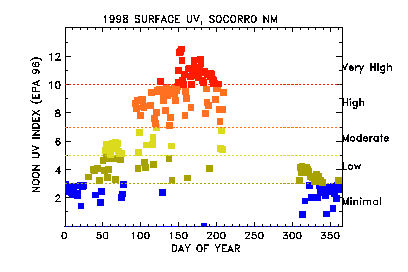



Brief Description: This is a project jointly supported by New Mexico Tech's Geophysical Research Center and by NASA's Total Ozone Mapping Spectrometer (TOMS) Science Team. We monitor biologically active UV-B radiation at the Earth's surface, take daily measurements of the total column of ozone over Socorro, and use radiative transfer models to interpret the measurements. Our goal is to gain a better understanding of the factors controlling the penetration of solar UV - including atmospheric variables such as ozone, cloud amount and type, and aerosol loading.
Methods: These are ground-based measurements using a 5-channel, filter radiometer. The radiometer measures the global (direct beam plus diffusely scattered) downwelling solar irradiance at 305, 320, 340, and 380 nm. The fifth channel measures photosynthetically active radiation (PAR) in a broad band over the visible spectrum. Sensors are temperature controlled for stability and calibration is accurate to within 3-5%. The radiometer has been in near continuous operation on the roof of Workman Center at New Mexico Tech since June 1997.
Data: Below are plots of the measured UV Index at noon for 1997 and 1998. The UV Index is the erythema weighted dose (skin damage) in Watts per square meter, multiplied by 40. Values over 10 are considered extremely high. The figures show that the noon UV Index routinely exceeds 10 during summer months in Socorro, primarily as a result of high sun, generally lower ozone values, and frequent clear skies (in early summer). The large seasonal variation is due to changing sun angle over the course of the year. Effects of clouds are also apparent in the scatter toward lower UV Indices.


We also find that ozone and the UV Index are highly anticorrelated. The relationship between ozone and UV is well described by a power law with a so-called Radiation Amplification Factor (RAF) of about one. This means that there is a nearly 1:1 relationship between percent changes in total ozone and UV Index, i.e., if ozone decreases by 10%, then the UV exposure increases by about 10%. Some of the latest results are discussed in a paper that appeared in Geophysical Research Letters in 1999. You can obtain a preprint of this paper from the preprint homepage.
SUMMER MONSOON: This figure shows the 380-nm irradiance averaged for 1/2 hour around 4 p.m., normalized by dividing by the clear-sky irradiance expected for the given solar zenith angle. Values of 1 thus indicate clear sky in the afternoon, and values less than about .5 are due to optically thick clouds.

This information is being made available by Ken Minschwaner at New Mexico Institute of Mining and Technology's Physics Department.